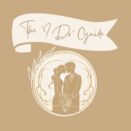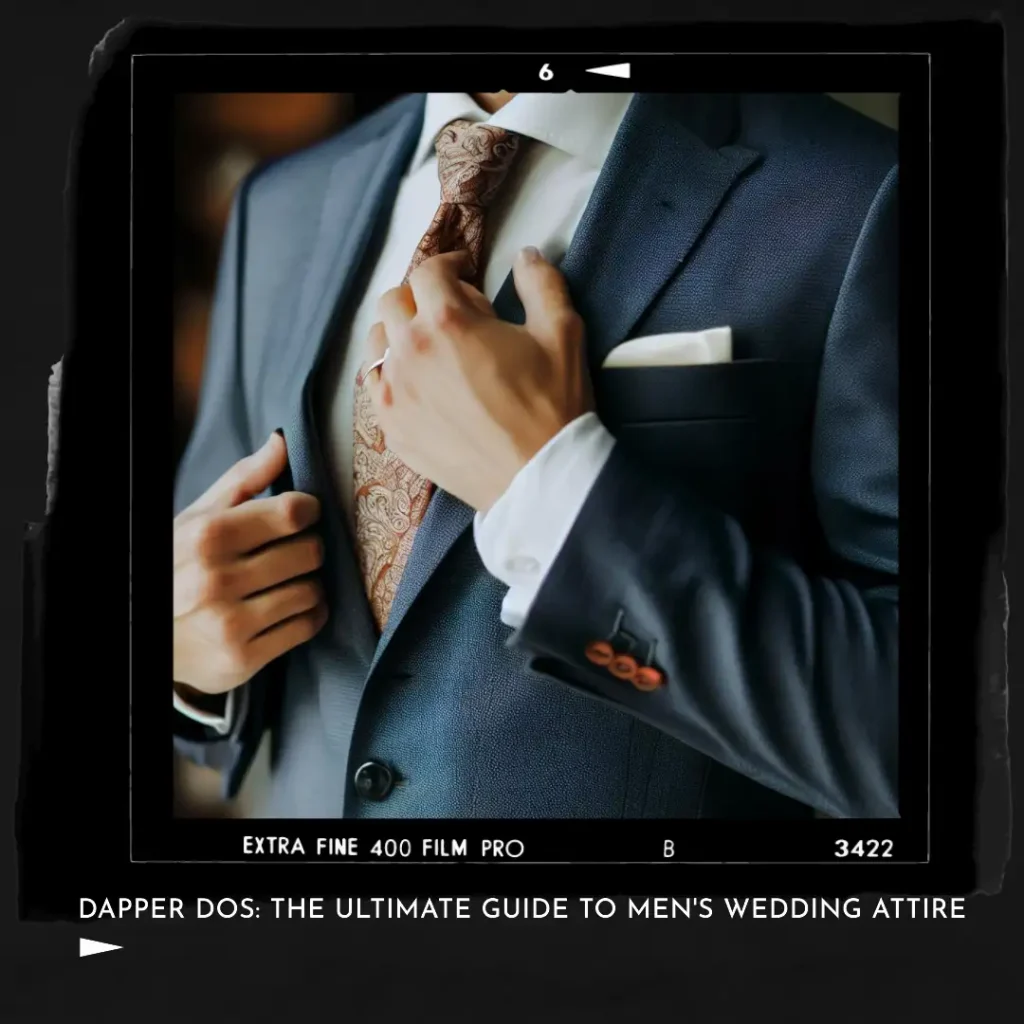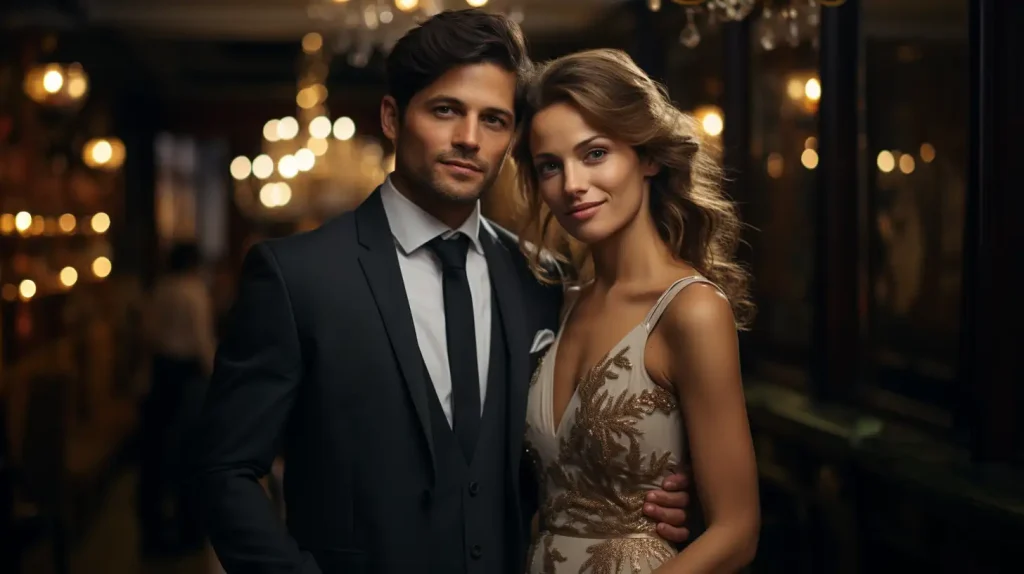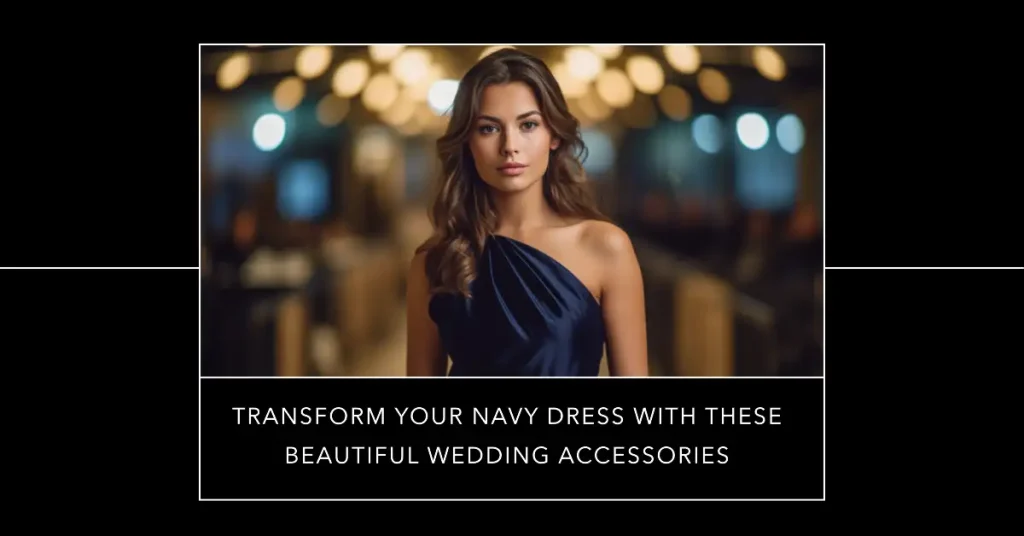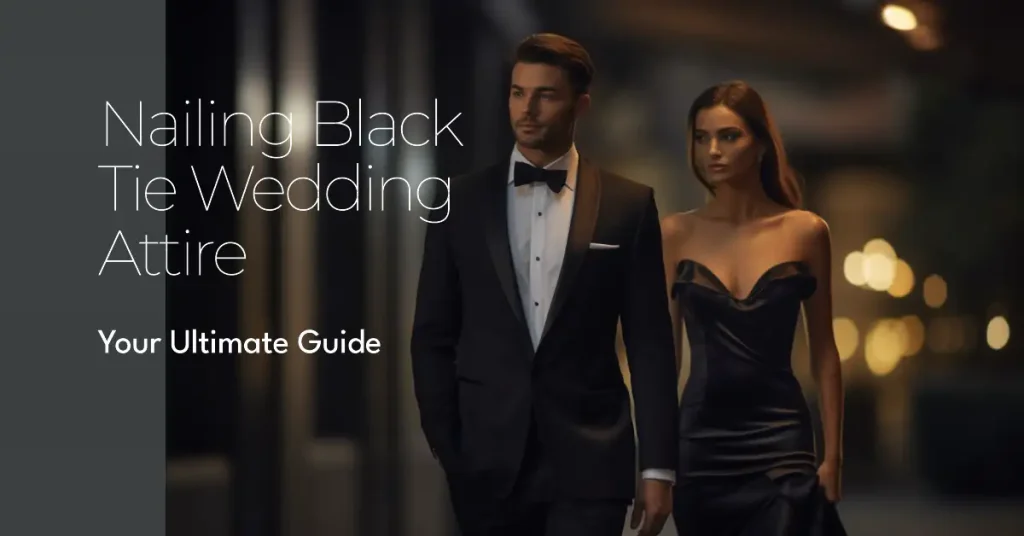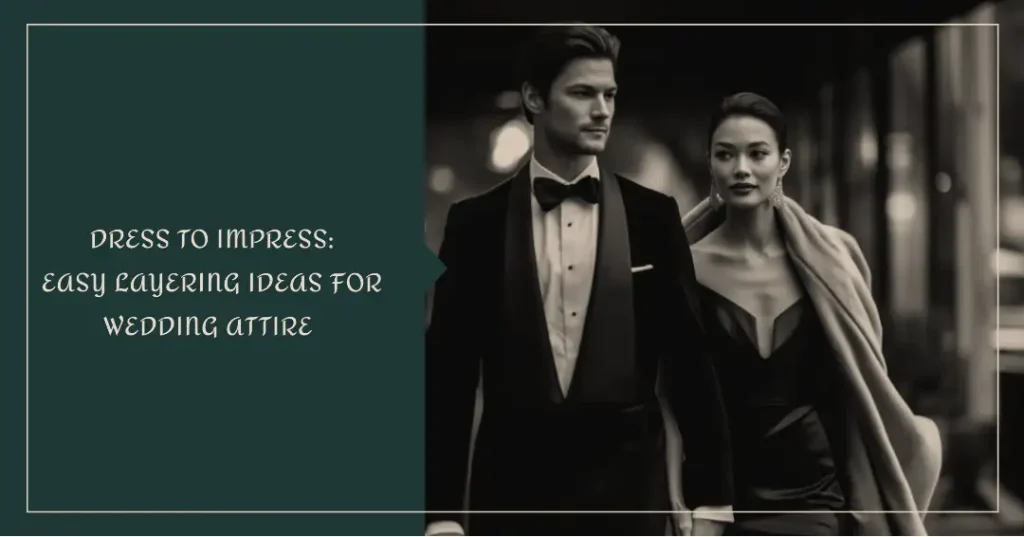Table of Contents
Men should wear a suit in a neutral color with a dress shirt, tie, and dress shoes for a wedding. Avoid casual attire like jeans, shorts, or t-shirts. Accessorize with a pocket square, cufflinks, or a watch. Dress neatly and conservatively to show respect for the occasion.
Key Takeaways
- Understanding Wedding Dress Codes: Different dress codes like black tie, formal or black tie optional, and casual have specific attire requirements. It’s important to know the dress code mentioned in the wedding invitation and dress accordingly.
- Suit Selection: Choose a suit that complements the wedding theme, season, and dress code. Consider factors like fabric (lightweight for warmer weather, heavier for cooler climates), color (darker shades for formal events, lighter hues for casual), pattern (solid-colored or subtle patterns for formal, bolder patterns for casual), and style (classic or contemporary).
- Shirt, Tie, and Pocket Square Coordination: Ensure your shirt collar complements your tie knot and overall outfit. Select ties that suit the occasion and complement the suit and shirt colors. Choose pocket squares that coordinate with your tie but don’t match it exactly.
- Footwear Selection: The right footwear completes your wedding ensemble. Oxfords are versatile and suitable for various dress codes, brogues add character, and loafers provide a more relaxed option. Match the footwear formality with the event, and ensure they are clean, polished, and well-maintained.
- Accessories: Pay attention to details like cufflinks, watches, belts, and suspenders. Coordinate cufflinks with the suit, shirt, and tie. Choose an elegant watch that complements your overall look. Select belts or suspenders that match your shoes and coordinate with other metal accessories.
- Dressing for Different Cultural Weddings: Understand specific attire customs for weddings in different cultures, such as Jewish, Muslim, Hindu, and Sikh weddings. Respect cultural traditions and dress modestly and appropriately.
- Renting or Buying a Suit: Consider factors like budget, frequency of use, and personal style when deciding to rent or buy a suit. Renting is suitable for occasional wear, while buying allows for customization and long-term use.
- Tailoring and Alterations: Investing in professional tailoring services ensures a well-fitted and polished appearance. Find a skilled tailor who understands menswear and can work with different fabrics and styles.
- Groom-specific Tips: As the groom, differentiate yourself from the groomsmen while complementing the bride’s attire. Stand out through suit style, color, or accessories. Coordinate with the best man for a cohesive groomsmen look.
- Dealing with Wardrobe Malfunctions: Be prepared for unexpected malfunctions like torn seams, missing buttons, or stains/spills. Carry emergency repair kits with safety pins, spare buttons, and stain removers. Seek professional help if needed.
You’ve received a wedding invitation, and now it’s time to plan your attire. As a man, dressing appropriately for a wedding can be quite the puzzle. Your outfit plays a significant role in creating the right atmosphere and ensuring you feel comfortable throughout the celebrations.
Decoding the Wedding Dress Code
To make a lasting impression and ensure you’re dressed appropriately, understanding the different wedding dress codes is essential. We’ll delve deeper into the most common dress codes, providing guidance on choosing the perfect ensemble:
- Carter, Lisa (Author)
- English (Publication Language)
- 107 Pages - 04/06/2024 (Publication Date) - Independently published (Publisher)
- Black Tie: Reserved for the most formal affairs, a black-tie event calls for a classic tuxedo. Opt for a black or midnight blue jacket with satin lapels, matching trousers with a satin stripe down the side, a pleated white dress shirt, and a black bow tie. A cummerbund or low-profile waistcoat in black or a color coordinating with your date’s attire will complete the look. For footwear, choose polished black dress shoes, such as patent leather oxfords or well-shined cap-toe oxfords.
- Formal or Black Tie Optional: This dress code allows for more flexibility. A tuxedo remains an acceptable choice, but you may also opt for a dark, well-tailored suit in charcoal, navy, or black. Pair it with a crisp white dress shirt, a conservative tie in a solid color or restrained pattern, and a pocket square that complements your tie. For footwear, select a pair of polished dress shoes, such as oxfords, brogues, or monk straps.
- Semi-Formal: The semi-formal dress code bridges the gap between formal and casual. Choose a suit in a lighter color like gray, navy, or even a subtle pattern, such as a windowpane or pinstripe. Coordinate your dress shirt and tie, opting for a more vibrant color or bolder pattern than you would for a formal event. Complete the look with a pair of well-maintained dress shoes, such as oxfords or brogues, and matching dress socks.
- Casual: A casual dress code invites guests to dress comfortably while maintaining a polished appearance. Pair a blazer or sports coat with dress pants or chinos in a coordinating color. Underneath, wear either a dress shirt or a more casual button-down, with the option to add a tie if desired. To finish the look, choose loafers, brogues, or derby shoes, depending on your preference.
- Beach or Destination Wedding: When attending a beach or destination wedding, embrace the relaxed atmosphere while still looking refined. Opt for a light-colored linen or cotton suit in shades like beige, tan, or light gray. Alternatively, consider dressy shorts paired with a linen or cotton dress shirt. For a more adventurous choice, don a stylish Hawaiian shirt with coordinating dress pants or chinos. For footwear, choose loafers or leather sandals that match the tone of your outfit.
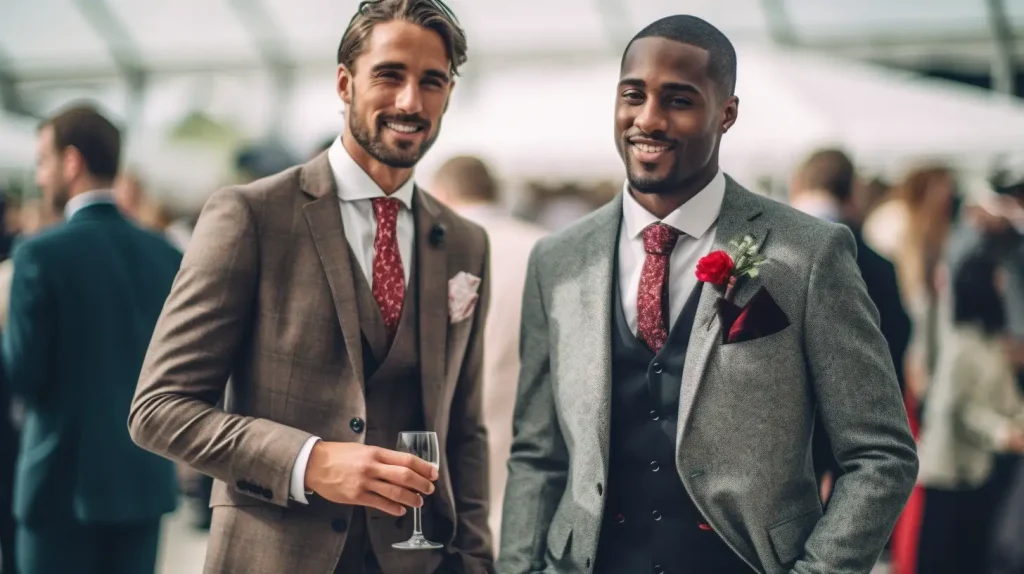
The Art of Suit Selection
Choosing the perfect suit for a wedding involves careful consideration of fabric, color, and style. By keeping these factors in mind, you’ll be able to select an ensemble that not only complements the wedding theme and season but also ensures your comfort throughout the event.
- Fabric: The material of your suit plays a crucial role in how comfortable you feel at the wedding. For warmer weather or outdoor ceremonies, opt for lightweight materials like linen, cotton, or seersucker. These breathable fabrics will keep you feeling cool and looking sharp. In contrast, for cooler climates or winter weddings, consider suits made of wool or heavier fabrics. These materials will provide warmth while still maintaining a refined appearance.
- Color: The color of your suit should be influenced by both the dress code and the season. For formal events, darker shades like charcoal, navy, or black are traditional choices. For semi-formal or casual dress codes, you can experiment with lighter colors such as light gray, beige, or even subtle patterns like windowpane or pinstripes. Additionally, consider the season when selecting a color. Lighter hues are more suitable for spring and summer weddings, while richer, deeper tones are appropriate for fall and winter events.
- Pattern: While solid-colored suits are always a safe bet, incorporating patterns can add visual interest to your outfit. For formal events, stick to subtle patterns like pinstripes or a muted glen plaid. For more casual dress codes, feel free to experiment with bolder patterns, such as windowpane, checks, or even a tasteful floral print.
- Single vs. Double-breasted Suits: Single-breasted suits are the most common choice, featuring one row of buttons and a narrow overlap of fabric. This style is versatile and flattering on most body types. On the other hand, double-breasted suits have two rows of buttons and a wider overlap of fabric, creating a more formal and traditional look. While this style can be quite elegant, it’s essential to ensure a proper fit, as an ill-fitting double-breasted suit can appear boxy or dated.
- Classic vs. Contemporary Styles: The classic suit features timeless elements such as notched lapels, a two-button jacket, and flat-front trousers. This style is always appropriate and works well for various dress codes. If you’re looking to make a bolder statement, a contemporary suit may be the right choice. Modern suits often incorporate slimmer fits, peaked lapels, unique button stances, or creative detailing. When opting for a contemporary suit, be mindful of the wedding’s formality and theme to ensure your ensemble remains tasteful and appropriate.
Shirt, Tie, and Pocket Square Coordination
A harmonious blend of shirt, tie, and pocket square can elevate your wedding ensemble, showcasing your attention to detail and personal style. Follow these guidelines to create a polished and cohesive look:
Shirt Collar Selection
The shirt collar you choose should complement your tie knot and overall outfit. Here are a few popular collar styles and their ideal tie pairings:
- Point Collar: The most common collar style, it pairs well with a variety of tie knots, such as the Four-in-Hand or Half Windsor.
- Spread Collar: With a wider gap between collar points, this style works best with larger tie knots like the Full Windsor or Pratt.
- Button-Down Collar: A more casual option, it suits smaller tie knots or can be worn without a tie for a relaxed appearance.
- Flex Fabric: The long sleeve dress shirt is made of stretch fabric,makes you move body easier;soft and comfortable with good breathability
- Wrinkle Free: The combination of high-quality fabrics and special technology makes the solid dress shirt not easy to wrinkle, easy to care.The classic spread collar easily matches with a tie or bow tie
- Occasion: Business/ Wedding/ Party/ Dating/ Office/ Nightclub, whether for formal occasions or daily casual, this mens dress shirt is a perfect choice. The classic design ensures it’s a staple in any wardrobe
- WRINKLE FREE: Developed for less wrinkles and easy care
- REGULAR FIT: A generous cut through the shoulders, chest and waist for total comfort and a classic fit
- POINT COLLAR: Classic collar thought to lengthen the face & allows for tie knot variety; can be worn with or without neckwear.
- Care: Machine wash,tumble dry or line dry,low temperature ironing
- Slightly Shiny Fabric:Like satin silk, this shirt has more shiny than cotton dress shirts. It is soft and comfortable to the touch, cool and smooth, beautiful and eye-catching, making it very suitable for weddings, balls, parties, and other events. If used in work or business occasions, it might be too shiny
- Slight Elasticity:Due to the fabric containing only 5% spandex, the elasticity is relatively weak. The elasticity of this shirt runs horizontally from left to right. Polyester-spandex blended fabric offers excellent stability,low shrinkage rate, durable
Tie Selection
The tie you choose should suit the formality of the occasion and complement the color of your suit and shirt. For formal events, consider a solid-colored silk tie or one with a subtle pattern. For semi-formal or casual dress codes, feel free to experiment with bolder patterns and colors, keeping in mind the overall theme and color palette of the wedding.
Tie Knots
The tie knot you choose should correspond to the formality of the event and the width of your shirt collar. Popular tie knots include:
- Four-in-Hand: A versatile and simple knot that works well for most occasions and collar styles.
- Half Windsor: A medium-sized knot that suits semi-formal and formal events, pairing well with point and spread collars.
- Full Windsor: A large, symmetrical knot that exudes formality, best suited for spread collars and formal occasions.
Pocket Square Coordination
A well-chosen pocket square adds a touch of personality and flair to your ensemble. Your pocket square should complement your tie but not match it exactly. Consider coordinating the color or pattern with elements of your tie or shirt. For example, if your tie features a small pattern, opt for a pocket square in a coordinating color with a larger pattern or a solid color that picks up a hue from the tie. For a solid-colored tie, choose a pocket square with a pattern that includes the tie’s color or a contrasting shade for a bolder statement.
Footwear for the Wedding Guest
The right footwear is essential for completing your wedding ensemble and ensuring your comfort throughout the event. Keep these factors in mind when selecting the perfect pair of shoes for any wedding dress code:
Shoe Styles
Different shoe styles convey varying levels of formality and can complement or clash with your outfit. Here are a few popular options and their ideal pairings:
- Oxfords: A classic and versatile choice, oxfords are suitable for formal, semi-formal, and some casual dress codes. Opt for black leather for black-tie events and consider brown or burgundy leather for less formal occasions.
- Brogues: Featuring decorative perforations, brogues add a touch of character to your look. These shoes are well-suited for semi-formal and casual dress codes, available in various colors and materials to match your ensemble.
- Loafers: A more relaxed option, loafers are ideal for casual and some semi-formal dress codes. Choose from classic leather, suede, or even velvet, depending on the wedding’s theme and your personal style.
Dress Code Considerations
Always ensure your footwear matches the formality of the event. For black-tie affairs, polished black oxfords are the go-to choice. If the event is formal or black-tie optional, oxfords and brogues in dark colors are appropriate. For semi-formal, casual, or beach weddings, you have more flexibility, with options ranging from brogues and loafers to even dressy leather sandals.
Socks
The right socks can add personality to your outfit and showcase your attention to detail. For formal events, opt for dress socks in a color that complements your suit or shoes. For semi-formal or casual dress codes, feel free to experiment with bolder patterns or colors that coordinate with elements of your ensemble, such as your tie or pocket square.
Shoe Maintenance
A well-maintained pair of shoes exudes sophistication and demonstrates your commitment to looking polished. Ensure your shoes are clean, polished, and free of scuff marks before attending any wedding. For suede or fabric shoes, use appropriate cleaning techniques to keep them looking their best.
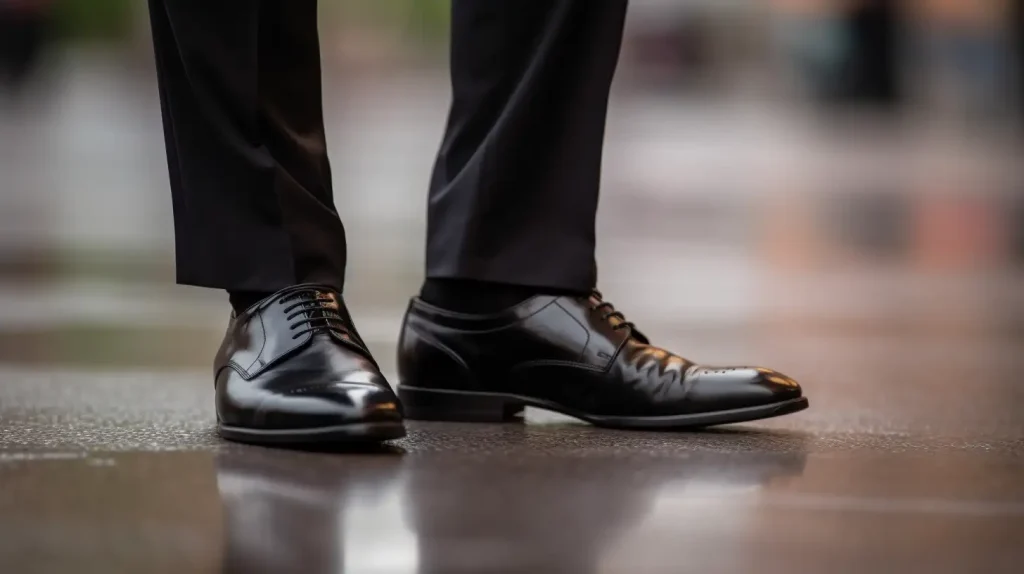
The Finishing Touches
Cufflinks, watches, and belts or suspenders are the final elements that bring your wedding ensemble together, showcasing your attention to detail and personal style. Keep these tips in mind when selecting the perfect accessories to complete your look:
- Cufflinks: Cufflinks add a touch of refinement and elegance to your outfit, especially for formal or black-tie events. Choose a pair that complements the color and style of your suit, shirt, and tie. For a classic look, opt for simple silver or gold cufflinks. If you prefer to make a statement, consider cufflinks with unique shapes, colored enamel, or tasteful gemstones. Ensure your cufflinks coordinate with any other metal accessories you’re wearing, such as your watch or belt buckle.
- Watches: An elegant timepiece not only serves a practical purpose but also showcases your sophistication. For formal events, choose a slim dress watch with a leather strap that matches your shoe color or a metal bracelet that complements your cufflinks. For semi-formal or casual dress codes, you have more flexibility, allowing for bolder watch designs, larger faces, or even smartwatches. Regardless of the style, ensure your watch is understated and doesn’t detract from the overall appearance of your ensemble.
- Belts or Suspenders: A well-chosen belt or pair of suspenders ensures your trousers sit properly while adding polish to your outfit. When opting for a belt, select one that matches the color and material of your shoes, with a buckle that coordinates with your other metal accessories. For a more traditional or formal look, consider suspenders, which should either match or complement your suit and tie. Note that suspenders and a belt should never be worn simultaneously, as this can create a cluttered appearance.
- Other Accessories: Depending on the dress code and your personal style, you may choose to incorporate additional accessories such as a tie bar, collar pin, or lapel pin. When selecting these items, ensure they coordinate with the overall look of your ensemble and don’t overwhelm your outfit.
Understanding the Wedding’s Theme and Colors
A critical aspect of dressing for a wedding is understanding the event’s theme and color scheme. This ensures that your attire complements the overall aesthetic of the wedding, creating a harmonious and visually pleasing atmosphere. Coordinating your outfit with the wedding’s theme and colors can also demonstrate your respect for the couple’s vision and their special day.
Importance of Coordinating Attire with the Wedding’s Theme and Colors
Paying attention to the wedding’s theme and colors can help guide your choice of attire, making it easier to select an appropriate ensemble that reflects the formality and style of the event. For example, a rustic-themed wedding may call for earth-toned suits and more casual footwear, while a glamorous, black-tie affair would require a classic tuxedo and polished dress shoes. Additionally, incorporating colors from the wedding’s palette into your outfit through ties, pocket squares, or socks can create a cohesive appearance among guests and the wedding party. This attention to detail can contribute to the overall success of the event, making it a memorable and beautiful experience for all involved.
Dressing for Religious or Cultural Ceremonies
Attending a religious or cultural wedding ceremony often requires additional consideration when selecting your attire. Understanding and respecting the customs and traditions associated with these ceremonies is essential, ensuring you dress appropriately and avoid causing offense. In this section, we’ll provide guidance on appropriate attire for various religious or cultural wedding ceremonies, including any specific requirements or traditions.
Christian Weddings
For traditional Christian weddings, men are generally expected to wear a suit or a tuxedo, depending on the formality of the event. It is essential to adhere to the dress code indicated on the invitation and be mindful of any specific dress requirements for the church or religious venue. For example, some churches may require men to remove their hats during the ceremony.
Jewish Weddings
In Jewish weddings, men are typically expected to wear a suit or tuxedo, again following the dress code specified on the invitation. It is customary for men to cover their heads with a yarmulke or kippah during the ceremony. Often, the hosts will provide yarmulkes for guests, but it is also acceptable to bring your own.
Muslim Weddings
For Muslim weddings, men should dress modestly and respectfully, typically wearing a suit or traditional attire, such as a sherwani or kurta pajama, depending on the culture. It’s important to avoid revealing clothing and ensure your outfit covers your shoulders and legs. Some Muslim weddings may also require male guests to cover their heads with a cap or headscarf during the ceremony.
Hindu Weddings
Hindu weddings often involve vibrant colors and elaborate traditional attire. Men can opt for a suit or traditional Indian clothing, such as a sherwani, kurta pajama, or dhoti. It’s important to avoid wearing black or white, as these colors are considered inauspicious in Hindu culture. Instead, embrace the colorful theme by incorporating shades of gold, red, or other bright hues.
Sikh Weddings
For Sikh weddings, men can wear a suit or traditional Indian attire, like a sherwani or kurta pajama. As with Hindu weddings, avoid wearing black or white and opt for more vibrant colors. Additionally, it is customary for men to cover their heads with a turban or headscarf when attending a Sikh wedding ceremony, particularly if held in a gurdwara.
By familiarizing yourself with the customs and traditions of the specific religious or cultural wedding ceremony you’ll be attending, you can ensure that your attire is both appropriate and respectful. Always adhere to the dress code specified on the invitation and, when in doubt, consult the hosts or other guests for guidance.
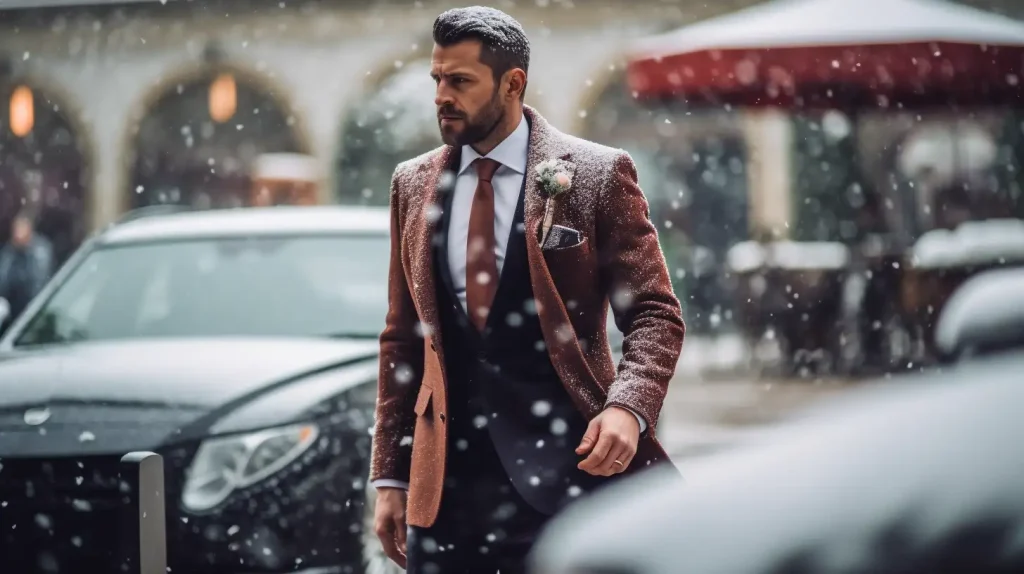
Seasonal Considerations for Wedding Attire
When planning your wedding attire, it’s essential to consider the time of year and the associated weather conditions. Selecting appropriate fabrics and colors for the season will not only ensure your comfort but also help you blend seamlessly with the overall theme and aesthetic of the wedding.
Spring and Summer Weddings
For spring and summer weddings, opt for lighter fabrics that are breathable and comfortable in warmer temperatures. Linen, cotton, and lightweight wool are excellent choices for suits, while seersucker can add a touch of whimsy and Southern charm. In terms of color, embrace the season by choosing lighter shades, such as light gray, beige, or pastel hues, which reflect the warmth and brightness of spring and summer. Patterns like windowpane, checks, or floral prints can also add a playful touch to your ensemble. Don’t forget to accessorize with lighter-colored ties and pocket squares to complete the look.
Fall and Winter Weddings
As the weather cools down, you’ll want to select fabrics that provide warmth while still maintaining a polished appearance. Heavier wool, tweed, and flannel are ideal choices for fall and winter weddings, keeping you cozy throughout the celebrations. In terms of color, embrace the richness of the season by opting for deeper shades, such as charcoal, navy, or burgundy. Patterns like herringbone, glen plaid, or pinstripes can add depth and texture to your attire. Complete your ensemble with darker-colored ties and pocket squares that reflect the season’s palette.
How to Rent or Buy a Suit for a Wedding
When attending a wedding, the decision to rent or buy a suit often comes down to factors such as budget, frequency of use, and personal style. This section offers guidance on making this choice and finding the perfect fit and style at various price points.
Renting a Suit
Renting a suit can be a cost-effective option, particularly for those who rarely attend formal events or prefer not to invest in a high-quality suit. Many rental services offer a wide range of styles, colors, and sizes, making it easy to find the perfect ensemble for any wedding dress code. To ensure a proper fit, visit the rental store well in advance of the event to try on different suits and make any necessary adjustments. Remember to also consider the cost of renting accessories such as shoes, ties, and pocket squares when budgeting for your wedding attire.
Tips for Renting a Suit:
- Research reputable rental companies in your area or online.
- Book your rental well in advance to secure your desired style and size.
- Try on the suit and schedule a fitting to make any adjustments.
- Inquire about rental policies, including return deadlines and fees for damages.
Buying a Suit
Purchasing a suit can be a worthwhile investment for those who frequently attend formal events or prefer a high-quality, tailored fit. When buying a suit, consider versatile styles and colors that can be worn for various occasions. While the initial cost may be higher than renting, owning a well-fitting suit can pay off in the long run, as it can be worn multiple times and tailored to your specific measurements. Additionally, buying a suit allows for more customization, such as selecting unique fabrics, patterns, and accessories to showcase your personal style.
Tips for Buying a Suit:
- Determine your budget and prioritize quality and fit.
- Visit multiple stores or consult with a tailor to find the perfect style and fit.
- Choose versatile styles and colors that can be worn for various occasions.
- Consider investing in quality accessories, such as shoes, ties, and pocket squares, to complete your ensemble.
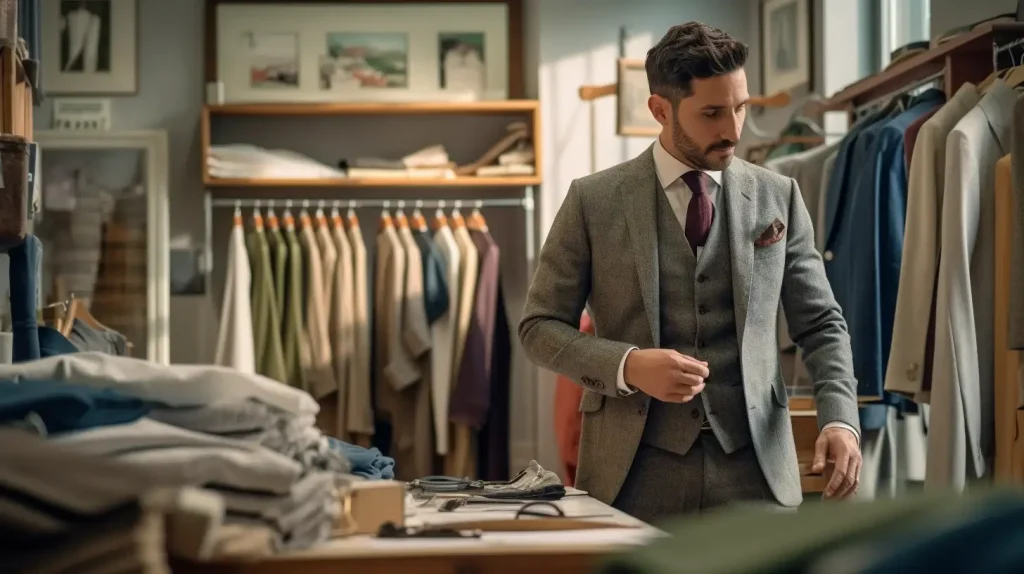
Tailoring and Alterations for the Perfect Fit
Achieving the perfect fit for your wedding attire is paramount, as it not only ensures comfort but also enhances your overall appearance. Tailoring and alterations play a crucial role in creating a polished and well-fitted ensemble, as they cater to your unique body shape and proportions. Regardless of the dress code or style of your suit, investing in professional tailoring services will elevate your look, showcasing your attention to detail and commitment to looking your best.
Finding a Skilled Tailor
To guarantee a flawless fit, it’s essential to find a skilled and experienced tailor who understands the intricacies of menswear and can work with various fabrics and styles. Begin by researching local tailors, checking online reviews, and seeking recommendations from friends or family who have had positive experiences. Once you have a shortlist of potential tailors, schedule consultations to discuss your needs and evaluate their expertise.
During the consultation, assess the tailor’s knowledge, communication, and professionalism. A proficient tailor should be able to address your concerns, offer valuable advice on alterations, and provide examples of their previous work. Additionally, inquire about the turnaround time for alterations and the estimated cost to ensure it aligns with your timeline and budget. By selecting a skilled tailor and prioritizing proper fit, you’ll ensure your wedding attire is both comfortable and visually stunning.
Groom-specific Tips
As the groom, your wedding day ensemble should not only adhere to the dress code but also set you apart from your groomsmen and complement the bride’s attire. Keep these tips in mind when planning your distinctive look for the big day:
- Stand Out from the Groomsmen: While it’s essential to maintain cohesion among the wedding party, you’ll want to differentiate yourself as the groom. This can be achieved by opting for a different suit style, color, or pattern. Alternatively, you can choose a unique tie, pocket square, or boutonniere to set yourself apart. For instance, if your groomsmen wear solid-colored ties, consider a patterned or textured tie for yourself that complements their look.
- Complement the Bride’s Attire: Work with your bride to ensure your ensembles harmonize with each other. This may involve coordinating colors, fabrics, or even design elements. For example, if the bride’s dress features lace detailing, consider incorporating a similar pattern in your tie or pocket square. Additionally, keep in mind the formality and theme of the wedding when selecting your outfit.
- Personal Touches: Your wedding day is the perfect occasion to showcase your personality through unique accessories or meaningful heirlooms. This could include custom cufflinks, a vintage tie pin, or a sentimental watch passed down through generations. These personal touches not only add character to your ensemble but also create memorable talking points for you and your guests.
- Comfort and Fit: As the groom, you’ll be at the center of attention throughout the day, so it’s crucial to feel comfortable and confident in your attire. Ensure your suit is well-tailored, allowing for ease of movement and a flattering silhouette. Don’t forget to break in your shoes before the big day to avoid discomfort or blisters.
- Pre-wedding Preparation: To ensure your ensemble looks its best on your wedding day, have your suit professionally cleaned and pressed beforehand. Gather all your accessories, including cufflinks, tie, pocket square, and any other items, and store them in a designated location to avoid last-minute stress.
The Role of the Best Man in the Groom’s Attire
The best man plays a vital role in supporting the groom during the wedding planning process, and this includes helping with the selection and coordination of the groom’s attire. As the groom’s right-hand man, the best man should be prepared to offer advice, assistance, and encouragement to ensure the groom looks and feels his best on his big day.
Offering Guidance and Support
The best man can help the groom research suit styles, colors, and fabrics that suit the wedding’s theme, dress code, and season. He should be prepared to accompany the groom to fittings and offer honest feedback on the fit and overall look of the attire. By providing valuable input and constructive criticism, the best man can ensure that the groom makes informed decisions and ultimately feels confident in his chosen ensemble.
Coordinating the Groomsmen’s Attire
In addition to assisting the groom with his attire, the best man should also take charge of coordinating the groomsmen’s outfits. This may involve liaising with the groomsmen to confirm measurements, ensuring that suit rentals or purchases are organized in a timely manner, and overseeing any necessary alterations. The best man should also make sure the groomsmen’s attire complements the groom’s outfit and adheres to the wedding’s dress code, color palette, and theme.
Ensuring Attention to Detail
The best man should be on hand to help the groom with the finer details of his attire, such as selecting the perfect shirt, tie, pocket square, cufflinks, and other accessories. He can assist the groom in coordinating these elements, ensuring a polished and cohesive look. On the wedding day, the best man should be prepared to assist the groom with dressing, tying his tie or bow tie, and making any last-minute adjustments to ensure the groom looks impeccable.
Providing Moral Support
Lastly, the best man should offer moral support to the groom during the wedding attire selection process. This may involve reassuring the groom about his choices, boosting his confidence, and reminding him that the focus of the day is the love and commitment he shares with his bride. By providing a listening ear and a supportive shoulder, the best man can help alleviate any pre-wedding jitters and ensure the groom feels relaxed and prepared for his big day.
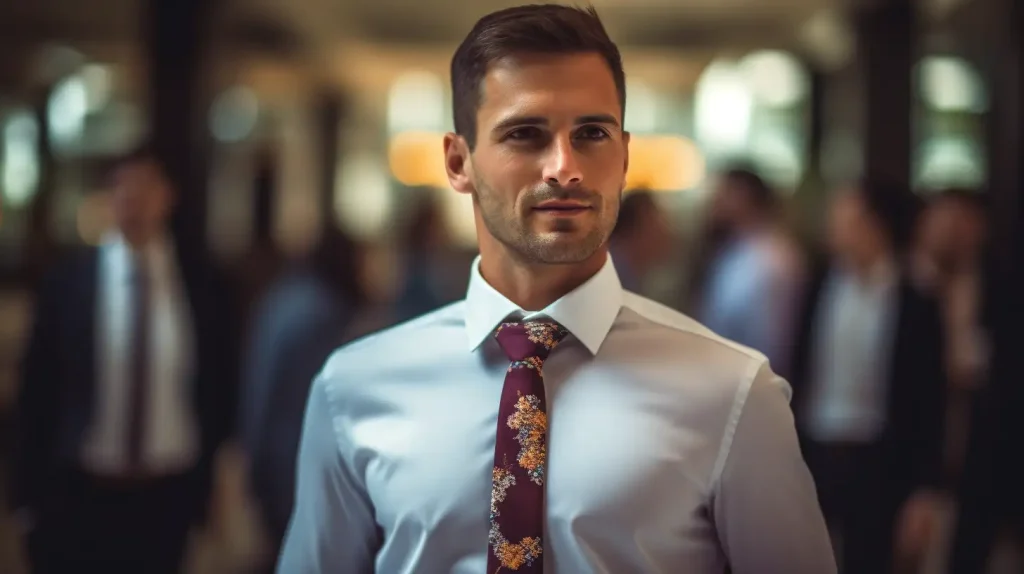
Wedding Etiquette for Men: When to Remove Jackets or Ties
When to Remove Jackets
At a wedding, it’s essential to balance formality with personal comfort. As a general rule, jackets should be worn during the ceremony and formal parts of the reception, such as speeches or first dances. However, once the dinner and dancing commence, it is acceptable to remove your jacket if the atmosphere becomes more relaxed and you feel the need for increased comfort. Before removing your jacket, observe the groom and other male guests to gauge if it is appropriate.
When to Remove Ties
While ties are an integral part of formal and semi-formal wedding attire, there may be instances where it is acceptable to remove them. Similar to jackets, it is essential to wear your tie during the ceremony and formal aspects of the reception. As the evening progresses and the event becomes more casual, you may remove your tie if you feel too warm or restricted. Keep in mind that the decision to remove your tie should be based on the overall atmosphere and the actions of other guests, including the groom. When in doubt, it’s always safer to keep your tie on to maintain a polished appearance.
- Length: 57.1″ (146CM) Width: 3.1″ (8CM) at widest
- Material: 100% polyester the neckties are well made, the stitching and thread are gorgeous
- Waterproof, HIGH QUALITY 6PCS
Navigating Last-Minute Wardrobe Malfunctions
No matter how well-prepared you are for a wedding, unexpected wardrobe malfunctions can still occur. It’s essential to remain calm and have a plan in place to handle these situations with minimal stress. The following tips will help you navigate any last-minute wardrobe issues that may arise on the big day.
Emergency Repair Kits
An emergency repair kit is a lifesaver when it comes to addressing wardrobe malfunctions. Assemble a small kit containing essential tools and items for quick fixes, including safety pins, a needle and thread, a small pair of scissors, spare buttons, a lint roller, and fabric tape. By having these items on hand, you’ll be better equipped to handle any unexpected issues that may arise.
Torn Seams
A torn seam can be a panic-inducing situation, especially on a wedding day. If you notice a torn seam, first assess the damage to determine the best course of action. If the tear is small, safety pins or fabric tape can provide a temporary fix. For larger tears, use a needle and thread to sew the seam back together. If sewing is not an option, consider seeking professional help from a tailor or seamstress nearby.
Missing Buttons
Losing a button from your suit or shirt can be a frustrating problem, but it doesn’t have to ruin your day. Check your emergency repair kit for a spare button that matches the ones on your outfit. If you don’t have an exact match, choose a similar button or one that is slightly smaller and less noticeable. Use a needle and thread to sew the button back on, ensuring it is securely fastened.
Stains and Spills
Accidents happen, and sometimes you may find yourself dealing with a stain or spill on your outfit. If the stain is small, use a clean cloth or napkin to gently dab the area, being careful not to rub the stain further into the fabric. For more stubborn stains, consider using a stain-removal pen or wet wipes to help lift the stain. In a worst-case scenario, try to camouflage the stain with a strategically placed accessory, such as a pocket square or boutonniere.
By preparing for potential wardrobe malfunctions and having an emergency repair kit on hand, you’ll be ready to handle any unexpected issues with confidence and grace, allowing you to focus on enjoying the wedding festivities.
How Should Men Dress for a Wedding? – Conclusion
Dressing well for a wedding not only boosts your confidence but also enhances your overall enjoyment of the special occasion. By following the guidelines provided, considering the dress code, and thoughtfully selecting your suit, shirt, tie, footwear, and accessories, you’ll create a polished and memorable ensemble. Prioritizing comfort ensures you can fully participate in the celebrations, from the ceremony to the dance floor, without distraction.
Remember, the key to success lies in understanding the intricacies of wedding attire and making informed choices that reflect both the event’s requirements and your personal style. When you look and feel your best, you can focus on what truly matters: celebrating the love and happiness of the newlyweds in style.
FAQs
Q: Should men match their outfit to their date’s dress?
A: It’s not necessary for men to match their outfit to their date’s dress. However, it’s a good idea to coordinate colors and styles so that the couple looks cohesive in photos.
Q: Can men wear a tuxedo to a wedding?
A: Yes, men can wear a tuxedo to a wedding if the invitation specifies black-tie attire. Otherwise, a suit is generally more appropriate.
Q: Can men wear brown shoes to a wedding?
A: It’s generally recommended to wear black dress shoes to a wedding, but brown shoes can be acceptable in some cases. If you’re unsure, check with the couple or follow the dress code on the invitation.
Q: Can men wear a hat to a wedding?
A: It’s generally not appropriate for men to wear a hat to a wedding, unless the wedding has a specific theme that calls for hats or headwear.
Q: Should men wear a boutonniere to a wedding?
A: If the couple has specified that guests should wear a boutonniere, then men should definitely wear one. Otherwise, it’s optional but can add a nice touch to the outfit.
Q: Can men wear a patterned suit to a wedding?
A: It depends on the formality of the wedding and the specific dress code listed on the invitation. In general, a solid-colored suit is more appropriate, but a subtle pattern such as pinstripes or a small check can be acceptable for a less formal wedding.
Q: Should men wear a tie to a wedding?
A: Yes, a tie is generally expected for men at a wedding. If the invitation specifies black-tie attire, a bow tie may be more appropriate.
Q: Can men wear a short-sleeved shirt to a wedding?
A: It’s generally not recommended to wear a short-sleeved shirt to a wedding, as this can appear too casual for the occasion. Stick with a long-sleeved dress shirt instead.
Q: Is it okay for men to wear a vest or suspenders to a wedding?
A: Yes, a vest or suspenders can add a stylish touch to a wedding outfit. Just make sure that they match the suit and shirt and don’t clash with any other accessories.
Q: Can men wear sneakers to a wedding?
A: No, sneakers are not appropriate for a wedding. Stick with dress shoes or loafers instead.
Q: Can men wear a white suit to a wedding?
A: It’s generally not recommended for men to wear a white suit to a wedding, as this can be seen as trying to upstage the bride. Stick with a more traditional suit color such as black, navy, or gray.
Q: Should men wear a belt with their suit to a wedding?
A: Yes, a belt is generally expected to be worn with a suit at a wedding. Just make sure it matches the shoes and doesn’t clash with any other accessories.
Q: Can men wear a colored suit to a wedding?
A: It depends on the formality of the wedding and the specific dress code listed on the invitation. In general, a neutral-colored suit such as black, navy, or gray is more appropriate, but a colored suit can be acceptable for a less formal wedding or if it coordinates well with the wedding theme or color scheme.
Q: Can men wear a patterned tie with a patterned suit to a wedding?
A: It’s generally not recommended to wear a patterned tie with a patterned suit, as this can appear too busy and clash. Stick with a solid-colored tie or a tie with a subtle pattern that complements the suit.
Q: Can men wear a lapel pin to a wedding?
A: Yes, a lapel pin can add a stylish touch to a wedding outfit. Just make sure it’s not too large or flashy and coordinates well with the rest of the outfit.
Q: Should men wear a wristwatch to a wedding?
A: Yes, a wristwatch can be a nice accessory to complete a wedding outfit. Just make sure it’s not too sporty or casual and coordinates well with the rest of the accessories.
COPYRIGHT NOTICE
Please be advised that all images, designs, and creative content on this page are the exclusive property of TheIDoGuide.com and are protected under international copyright laws. The images may not be reproduced, copied, transmitted or manipulated without the written permission of TheIDoGuide.com.
Unauthorized use, distribution, display, or creation of derivative works of any images contained on this site, is strictly prohibited and can lead to legal penalties. We actively monitor for, and enforce, our copyright interests.
If you wish to use any of our images, kindly contact us to seek permission. Respect of copyright is not merely a legal requirement but also an acknowledgement and support of the hard work and creativity that goes into producing them.
Thank you for your understanding and cooperation.
© 2023, TheIDoGuide.com. All Rights Reserved.
